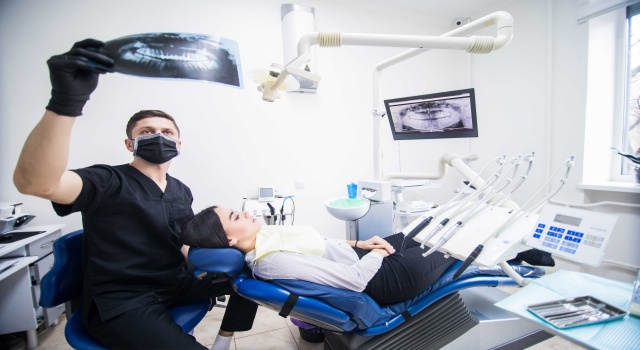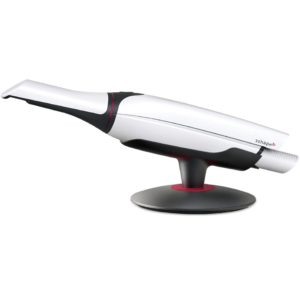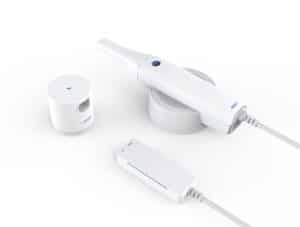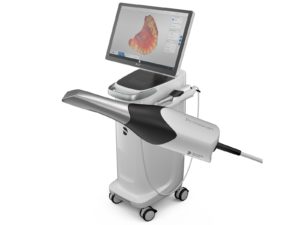Table of Contents
Dental Intraoral scanners are the future of dentistry; the current technological advancements are favoring professionals in the medical industry and promoting good health and simplifying the various clinical procedures through the use of innovative gadgets.
The innovative Intraoral scanners have been deemed effective for capturing impressions used to fabricate prosthetic restorations. And the best thing about the above procedures is that they can be done on patients with implants and those with natural teeth.
What is a Dental Intraoral Scanner?
Intraoral scanners are devices used to capture optical impressions; to achieve the above, the scanners have been designed to project a light source on the area inside your mouth that is to be scanned. Images are then captured by the imaging sensor and processed using the scanning software, producing 3-dimensional surface models.
Dental Intraoral Scanner: Criteria for evaluation
1. Intraoral Scanner Speed
Intraoral Scanners are time efficient, although it is important to note that the time difference does not relate to its ability to capture the full scan; time efficiency is, therefore, fully achieved regarding the processing of the respective scans. Recently, the intraoral scanners have undergone some major innovations and can perform a full intraoral scan in less than 30 seconds.
2. Intraoral scanning flow
Intraoral scanning flow is all about the seamless use of the device and its effectiveness when dealing with complex cases. Therefore, the scanners have been proved effective when dealing with severe undercuts or when used to scan multiple implants; what’s more, is that the workflow of the IOS is more significant when the clinician has to recapture the impressions without necessarily having to repeat the entire procedure.
However, we cannot turn a blind eye to the pronounced inability of the intraoral scanner to detect deep marginal lines on prepared teeth or in situations where the patient has bleeding gums.
3. Intraoral scanning size
The big question regarding the size of the intraoral scanner is whether it matters; well, if we consider operability, then the size is of importance. Some scanners from the outlook are bulky to use for certain procedures. Therefore, most companies have made considerable efforts in making user-friendly scanners; the above then means that the different scanner sizes are meant for different categories of users. Most importantly, big scanners with larger windows don’t need to be moved around the oral cavity, while small scanners are used on the smaller mouths.
4. Ease of use
Younger clinicians always have an easy time with technological gadgets. The older clinicians are still not very passionate about technology, meaning there is a steep learning curve for the latter group. It is important to note that the different scanning devices don’t utilize the same strategy before they can derive the relevant results.
Therefore, it should be known that no one scanning strategy is better than the other because the different devices have their unique way of functioning.
5. Intraoral scanner price
The price of an intraoral dental scanner also captures its ability to benefit a particular dental practice. Before settling on a specific intraoral scanning device, clinicians need to carry out extensive research; therefore, they will have to look at the technical specs, the overall price and check for other hidden costs. Remember also that many of them become obsolete when it comes to technological devices once the more advanced units are unveiled.
In essence, therefore, getting a scanner is quite costly, more especially if you get one that cannot perform both the basic and advanced functions; because of the above, a practice could suffer financially as the simple operations will proceed at a snail’s pace?
6. Subscription Price
Medical equipment has a unique modus operandi and might require occasional servicing, while others might require software updates to ensure a seamless operation. When combing the perfect dental intraoral scanner markets, the clinicians need to consider whether they are ready to commit to the ongoing costs after they have invested in the equipment.
Therefore, most scanners will require the clinician to pay the maintenance fees, the servicing fees, or the subscription fee, which are, at times, mandatory if the clinician is to benefit from using the devices fully.

Things to Consider Before Buying the Dental Intraoral Scanners
Imaging quality
There are no two ways about this; most of the advanced dental intraoral scanners transmit the 3D models to laboratories for analysis, which is why image quality is of paramount importance. It is important to note that the scanning process and technique are dependent on the clinician’s skills; resolution, on the other hand, is dependent on the effectiveness of the projector, the software filters, and the number of cameras that have been incorporated into the scanner.
The best way to go about this is to get the pre-taken images by the distributor’s scanner and then evaluate their quality.
Software
The criteria for evaluating the dental intraoral scanner software are pretty direct. There are a few specific functionality features that clinicians need to look out for; for example, the software should enable seamless connectivity to the lab. The user interface should be responsive and intuitive. Lastly, the software should be upgraded frequently. Some of the incorporated software also enables clinicians to access third-party software.
Versatility
Most of the intraoral scanners are versatile; clinicians must ensure that they invest in a device that will complement most of the procedures they will perform in their practice. There are, however, some single-purpose scanners, meaning that it all boils down to the practice and the procedures being run.
Hardware size
Intraoral scanners must be easy to use and comfortable for both the clinician and the patient; clinicians must also remember that the easier it is to use, the faster they will learn how to operate the unit, thus saving time and enjoying their full ROI.
Therefore, the size of the camera depends on the practice; important to remember, however, is that if the camera is large, then operability will be limited, but then again, with a small camera, there might be limitations in the number of procedures carried out.
Cost
The recommended time frame to use an intraoral scanner is 5 years, at least when compared to the initial investment cost and the subsequent subscription and maintenance costs. Intraoral scanners are quite expensive, meaning that if you invest in one, they should enable your practice to save money and make money. The units should, therefore, offer an ROI and more profits within the estimated lifespan.
The cost of an intraoral scanner also directly relates to the clinician’s budget and the practice’s size. It would be best for new practitioners to settle with a unit that can be easily operated and monetized. Once they are familiar, then clinicians can invest in more technologically advanced units.
Support
New technology is not always easy to use, and that is why clinicians need a responsive support team, mostly from their supplier or product manufacturer. What’s more, the relevant intraoral scanning device might not be all that intuitive. Thus, someone must guide them through it before they completely get the hang of it. The above is why getting a unit that comes with the relevant support is of utmost importance.
Warranty
As with most expensive electronic or technological equipment, the attached warranty offers security, which gives the clinicians one less thing to worry about. An intraoral scanner retailing without a warranty could raise a good number of eyebrows as regards quality. Besides, all the legitimate companies that manufacture the intraoral scanners need to stand behind their companies and show people they trust in their products.
And the only way to achieve the above is through the warranty; the features that clinicians will be looking out for are whether they will be given a new unit or whether the device will be repaired. They also need to find out what the warranty covers and how long it will take when processing the warranty.
What is the best dental intraoral scanner? Here are Intraoral scanner reviews for your Dental Practice.
1. 3Shape TRIOS 4 ($26,999.00)

Weighing a mere 375g inclusive of the battery, the 3 Shape Trios 4 will advance your dental practice as it has been configured to allow users to create custom surgical guides, complete with the temporary screwed retained crowns in a single workflow. The device allows clinicians to keep track of the changes of their patient’s teeth, enabling early identification of the various dental conditions.
The 3shape Trios 4 is pretty easy to use as users can either use it in wired or wireless mode. They have to use the simple plug cord to switch between the different modes. Featuring the most advanced technology, the 3Shape Trios 4 scanner is a scanner, thanks to the instant heat technology. The unit can additionally scan 2 to 3 times more patients than its predecessors and is equipped with the built-in fluorescent technology necessary to identify possible carriers.
Pros
- The battery life is increased
- The instant heat technology enables optimized scanning.
- Can be used to design a patient’s beautiful smile
Cons
- High initial investment costs
2. Medit i500 ($10,500.00)

Looking to reduce chair time, then the Medit i500 is the perfect Intra-Oral scanner for your practice. The unit has effectively obliterated the use of mold materials and powder. It allows the clinicians to carry out quick scans, which, when coupled with the intelligent scan technology, conveniently slashes each patient’s chair time.
And even though users will have to use their own devices, either a laptop or a desktop device, operations are pretty seamless when using the application. Therefore, clinicians will be presented with an intuitive dashboard, where they can easily perform their analytics; they can also store information on the cloud storage, communicate, and even integrate the relevant payment features.
The innovative intraoral scanner enables clinicians to easily match the scan bodies’ scan abutments thanks to the Artificial Intelligence Abutment and Artificial Intelligence scan body matching. Clinicians also have the liberty to automatically or manually create the margin line and edit the functions while scanning the patients.
Pros
- Clinicians can perform the pre-operational scans
- Enables sorting and merging of data in real-time, which can be used later for modeling
- The unit can be used to carry out high-resolution scans in specific areas.
Cons
- The dental intraoral scanner has a steep learning curve.
3. Cerec Primescan ($19,999.00)

The Cerec primescan comes as a full unit, complete with a monitor and a stable workstation. With this unit, clinicians will perform the various functions with improved accuracy and impressive speeds. Even better is that the device is versatile as it enables the clinicians to carry out all sorts of treatments, ranging from a single tooth to a full arch.
Primescan, according to Dentsply Sirona, is the perfect unit for new dentists, as it enables them to design their workflows easily; the unit comes equipped with two independent software configurations, one that supports the chair side workflows and the other one that offers support to the connection of the established partner’s workflow.
Pros
- The dental intraoral scanner easily scans the hard-to-reach areas while offering an increased field of view.
- Easily consolidates over 50,000 images per second.
- The dynamic depth scan technology and the innovative smart pixel sensor enable the creation of sharp images.
- It offers open data transfer options, thus accelerating the workflow.
Cons
- The scanner is power-dependent.
4. CS 3700 Carestream
The CS 3700 Carestream is one of the dental intraoral scanners whose manufacturers offer continuing education through the training program. They provide their clients with immediate software updates and extend the standard warranty just so that they can accommodate the clinician’s needs.
Out of the box, the scanner comes equipped with the next-level technology. For example, the smart shade technology enables the unit to detect the scan area’s enamel color when searching for restorative options. The clinician will also merge the partial impressions with the digital in vivo can into one file.
The professional intraoral scanner enables seamless workflow, and users will be able to enjoy up to 60% faster processing speeds. Sharing the information to third parties has also been simplified, while the scan flow software allows clinicians to pursue the different indications from just a single scan.
And with the right PC configuration, users can be sure of comfort and enhanced functionality; for example, the scanner features an ergonomically grip channel known to offer balanced scanner control. Users also get to use the wrist wrap, which effectively connects them to the wrist wrap, thus prevents unnecessary damage from dropping.
Pros
- Enables one-touch export capabilities
- Offers unlimited workflow
- The wrist connect prevents damage from falling.
- Clinicians are provided with a clear view of the scan.
Cons
- The learning curve is steep.
5. Emerald S Planmeca ($12,999.00)

Emerald S Planmeca is a state-of-the-art dental intraoral scanner designed to improve your intraoral scanning speeds, and at the same time, furnish the clinician with the new diagnostic capabilities. With this unit, clinicians can ensure that they will save time because the device offers faster scanning speeds that will run in less than one minute and effectively cover the entire arch, no matter the procedure.
The scanner sports a sleek and slim design and will, therefore, fit on the user’s hand and the patient’s oral cavity. What’s more is that dentists will be treated to lifelike images, offering the clinician much-needed precision to derive positive, predictable results. Apart from detecting carriers, the intraoral scanner can be used for almost all intraoral scanning types and enables the clinicians to reach the posterior teeth capturing the inter-proximal areas easily.
Planmeca allows networking, and clinicians can import and export digital impressions via the STL and PLY file formats. Apart from its lightweight, the intraoral scanner is quite comfortable when used inside a patient’s mouth, and for the clinicians, it is quite smooth to handle.
Pros
- Allows the exportation of the dental impressions to partners
- Easy detection has been enabled with ease of rotating and scanning
- Dentists can easily detect the tooth shade thanks to the tooth shade assistant
- The Intraoral scanner can easily complement the color scheme of the various dentist clinics
Cons
- The learning curve is steep with a high cost of training
- Initial set up is costly
6. 3M True Definition Scanner
Of the intraoral scanners that we have reviewed, the 3M true definition scanner turns out to be the most affordable and designed to suffice most of the new dental practitioner needs. With this unit, dentists have been guaranteed accuracy when compared to some of the leading intraoral scanners in the market.
The unit does not have a steep learning curve, thanks to its innovative design that allows for fast, easy, and comfortable scanning. And to prove that the intraoral scanner is not only budget-friendly but effective, clinicians will be able to use them to for the below applications, orthodontics appliances, inlays and Onlays, implant workflows, and for the crown and bridge.
Pros
- Easy to use thanks to its ergonomic design
- Retails at a budget-friendly price, thus good for new dental practitioners
- The unit is not only accurate but consistently accurate.
- Small wand size allows easy operation.
Cons
- High hardware investment costs
7. Cerec Omnicam
Though power dependent, the Cerec Omnicam is bound to make your scanning more effective, thanks to its ability to provide clinicians with a 3D full jaw scan in true natural color; the units sleek and lightweight design allows it to easily fit on the clinician’s hand, making scanning pretty intuitive and easy.
The camera is powder-free, which, apart from making an impression taking easy, helps save time. Its slim design allows swift and seamless scanning of the posterior teeth without requiring the patient to assume a specific position. The incorporated software makes work easier, as the feedback and detailed instructions will inform the clinicians of their next steps.
What’s more, is that the produced digital data enables rapid exportation to other external service providers. Out of the box, the unit comes with a touchpad complete with a 16:9 wide-format touch screen. The unit is also fully mobile, and users will not have to worry about losing their case files thanks to the 60-minute battery buffer.
Another important feature is that the surfaces are closed, which enables faster and seamless disinfection. And for the clinicians running large segmented clinics, can easily move the intraoral scanner from room to room, with the option of conducting separate scanning and designing procedures.
Pros
- The oral scan provides clinicians with hints on the loss of tooth substances such as dental fractures.
- Clinicians can check for tooth movement before and after treatment.
- The unit is absolutely mobile and comes equipped with a 60-minute battery buffer.
- The closed design allows for easy disinfection.
Cons
- Not versatile for use in many applications
- High initial installation costs
Conclusions
A study carried over the period ranging from 2007 to 2017 discovered that the Intraoral scanner’s capability to directly capture the dental arch image inclusive of their 3D models obliterated the momentary discomfort imposed on patients using the physical impressions.
Therefore, the use of intraoral scanners has proved successful in patients and especially children with a strong gag reflex, as they have exhibited high intolerance of the traditional procedure. Overall, the Intraoral Dental scanners are time efficient, eliminate patients’ discomfort, and, apart from enhancing the dental practice, offer a Return on Investment.
